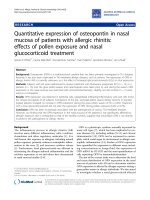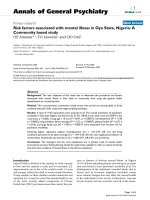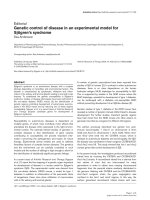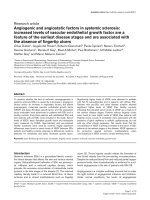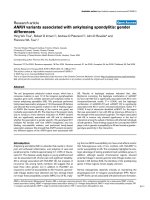Báo cáo y học: "BK virus associated meningoencephalitis in an AIDS patient treated with HAAR" potx
Bạn đang xem bản rút gọn của tài liệu. Xem và tải ngay bản đầy đủ của tài liệu tại đây (497.38 KB, 5 trang )
BioMed Central
Page 1 of 5
(page number not for citation purposes)
AIDS Research and Therapy
Open Access
Case report
BK virus associated meningoencephalitis in an AIDS patient treated
with HAART
José E Vidal
1,5
, Maria C Fink
6
, Filiberto Cedeno-Laurent
10
, Serena Delbue
8
,
Pasquale Ferrante
7,8
, Rafi F Dauar
3
, Francisco Bonasser Filho
1
,
Roberta Schiavon Nogueira
1
, Eduardo E Calore
4
, Claudio S Pannuti
6
, J
Roberto Trujillo*
10
and Augusto C Penalva de Oliveira
2,9
Address:
1
Department of Infectious Diseases, Emilio Ribas Institute of Infectious Diseases, São Paulo, Brazil,
2
Department of Neurology, Emilio
Ribas Institute of Infectious Diseases, São Paulo, Brazil,
3
Department of Neurosurgery, Emilio Ribas Institute of Infectious Diseases, São Paulo,
Brazil,
4
Department of Pathology, Emilio Ribas Institute of Infectious Diseases, São Paulo, Brazil,
5
Department of Infectious Diseases, São Paulo
University, São Paulo, Brazil,
6
Laboratory of Virology of the Institute of Tropical Medicine, São Paulo University, Brazil,
7
Laboratory of Molecular
Medicine and Biotechnology of Don C. Gnocchi Foundation ONLUS, IRCCS, Milan, Italy,
8
Department of Technology and Biomed Sciences
University of Milan, Italy,
9
Clinical Research Unit on Human Retrovirology, University of Campinas, São Paulo, Brazil and
10
Institute of Human
Virology, University of Maryland Biotechnology Institute, UMD, USA
Email: José E Vidal - ; Maria C Fink - ; Filiberto Cedeno-Laurent - ;
Serena Delbue - ; Pasquale Ferrante - ; Rafi F Dauar - ;
Francisco Bonasser Filho - ; Roberta Schiavon Nogueira - ; Eduardo E Calore - ;
Claudio S Pannuti - ; J Roberto Trujillo* - ; Augusto C Penalva de Oliveira -
* Corresponding author
Abstract
A severely immune-suppressed AIDS patient was suspected of suffering from BK virus (BKV)
meningoencephalitis, after being studied for common causes of neurological complications of co-
infectious origin. Polymerase chain reaction (PCR) and sequence analysis of cerebrospinal fluid and
brain samples, confirmed the presence of BKV. His clinical condition improved along with the
regression of brain lesions, after modifications on his antiretroviral regime. Five months after
discharge, the patient was readmitted because of frequent headaches, and a marked inflammatory
reaction was evidenced by a new magnetic resonance imaging (MRI). The symptoms paralleled a
rising CD4
+
lymphocyte count, and immune reconstitution syndrome was suspected. This is the
first non-postmortem report of BKV meningoencephalitis in an AIDS patient, showing clinical and
radiographic improvement solely under HAART.
Background
Neurological complications associated with HIV-1/AIDS
are being recognized with a high frequency that parallels
the increased number of AIDS cases [1]. Since the intro-
duction of HAART, morbidity and mortality secondary to
primary and secondary neurological opportunistic dis-
eases in HIV-1/AIDS patients have significantly decreased
[2,3]. However, neurocognitive impairments continue to
occur in high frequencies, even in countries, with a free
and universal access program to HAART, such as Brazil
[4].
Recently, atypical presentations of brain diseases, such as
JC virus granule cell neuronopathy, and those related to
Published: 8 June 2007
AIDS Research and Therapy 2007, 4:13 doi:10.1186/1742-6405-4-13
Received: 23 April 2007
Accepted: 8 June 2007
This article is available from: />© 2007 Vidal et al; licensee BioMed Central Ltd.
This is an Open Access article distributed under the terms of the Creative Commons Attribution License ( />),
which permits unrestricted use, distribution, and reproduction in any medium, provided the original work is properly cited.
AIDS Research and Therapy 2007, 4:13 />Page 2 of 5
(page number not for citation purposes)
the reconstitution of the immune system after initiation
of HAART have been reported in a growing basis [5-7].
These unusual neurological pictures in AIDS patients rep-
resent new diagnostic and therapeutic challenges [7,8].
BKV meningoencephalitis is a rare polyomaviral infection
with fatal outcome when associated with AIDS [9-11]. The
clinical picture is devastating, resulting in death from
multi-organ failure [12]. Here, we describe the clinical
course of an AIDS patient with presumed BKV menin-
goencephalitis who showed substantial improvement
after modification of his HAART regime.
Case presentation
In April 2004, a 43-year-old HIV-1 positive heterosexual
male was admitted to the hospital complaining of bilat-
eral headache of moderate intensity accompanied by
speech, gait and memory disturbances. HIV-1 infection
was diagnosed in July 2003 after an episode of cryptococ-
cal meningitis; with a documented CD4
+
lymphocyte
count of 6 cells/mm
3
. His past medical history includes an
episode of pancreatitis secondary to lopinavir/ritonavir
(July, 2003), and an episode of tuberculous meningitis
(October, 2003). On admission, antiretroviral medica-
tions included zidovudine, lamivudine, and efavirenz
(antiretroviral scheme modified after pancreatitis in
August, 2003). Other medications included: fluconazole,
TMP-SMX, isoniazid, ofloxacin, ethambutol, and pyrazi-
namide (rifampin was discontinued and replaced by
ethambutol and ofloxacin after a marked increased of
hepatic enzymes in November, 2003)
Initial examination revealed mental confusion, dysarthria
and ataxia. Baseline cranial CT scan showed two
hypodense lesions with mass effect and no contrast
enhancement in the left temporo-parietal and right occip-
ito-parietal areas. His CD4
+
lymphocyte count was 37
cells/mm
3,
with an undetectable viral load. Presumptive
cerebral toxoplasmosis was diagnosed, and a treatment
with sulphadiazine-pyrimetamine, folinic acid, and dex-
amethasone was started. After 14 days of therapy, the
patient's neurological status and CT scan findings
remained unchanged. Analysis of the cerebrospinal fluid
(CSF) obtained on day 14 after admission showed 12 leu-
kocytes/mm
3
(79% lymphocytes, 10% monocytes), glu-
cose of 46 mg/dl and a protein level of 146 mg/dl. Herpes
simplex encephalitis was suspected, and acyclovir
replaced the medications for toxoplasmosis. After a week
on this therapeutic regime, the patient's neurological sta-
tus remained unaltered, and PCR analysis of CSF was per-
formed, resulting negative for all human herpes viruses,
JCV, and for Toxoplasma gondii. Nevertheless, PCR for
polyomavirus BKV resulted positive.
From this data, acyclovir and dexamethasone were dis-
continued, and the patient underwent MRI-guided stereo-
tactic brain biopsy of the lesion found in the right
occipital lobe. Intraoperative MRI findings were similar to
those previously seen by CT scan (Figure 1A). Histopatho-
logical examination showed thickened leptomeninges
with a lymphocytic infiltrate that extended perivascularly
(Figure 2A). The underlying cortex showed mild astrocy-
tosis with prominent hypertrophic nuclei and bi-nucle-
ated forms (Figure 2A). PCR examination of the brain
tissue sample also showed the presence of BKV DNA in
the absence of any other polyomaviruses (Figure 2C and
2D). The patient was reclassified as with presumptive BKV
subacute meningoencephalitis. His therapeutic regime
included the replacement of efavirenz for atazanavir-
ritonavir along with the administration of zidovudine/
lamivudine, leaving the patient exclusively with HAART.
Urine analysis and renal function tests were performed,
showing <10 leucocytes/field, undetectable red blood
cells and proteins, a serum creatinine of 0.8 mg/dl, and a
BUN of 16 mg/dl. These values, discarded the presence of
renal and urinary abnormalities that are normally present
in the context of BKV clinical infection. Four weeks after
admission, neurological manifestations improved consid-
erably, and the patient was discharged.
Five months after discharge, the patient complained of
mild headaches. A new MRI reported improvement of the
two lesions previously seen; however, new areas of
increased signal intensity of the white matter appeared
(Figure 1B). Based on a rising CD4
+
lymphocyte count of
144 cells/mm
3
, and in the absence of any other co-infec-
tious agent, "encephalopathy of unknown origin" secondary
to immune reconstitution was suspected. We kept close
follow-up without any other intervention, and the patient
gradually recovered.
Seven months after discharge, MRI lesions and CD4
+
lym-
phocyte count further improved (Figure 1C.). Since then,
and until May 2007, the patient has been in the same
HAART regime, with no neurological complaints; his
renal and liver function have always been unaltered, and
his last CD4
+
lymphocyte count was of 336 cells/mm
3
with a viral load bellow 400 copies/ml.
Methods
Serum Hiv-1 viral load detection
All quantifications of viral load were performed by real-
time RT-PCR. The threshold of detection was 400 copies/
ml.
BKV and JCV DNA amplification from CSF samples
PCR technique as described by Arthur et. al.,[13] was used
to amplify the T-antigen gene (173 bp) of both, BKV and
JCV. To establish whether BK viral sequences inhibited the
AIDS Research and Therapy 2007, 4:13 />Page 3 of 5
(page number not for citation purposes)
reaction, 10 µl of CSF sample were added to duplicate
tubes containing the PCR mixture and polyomavirus
cloned DNA. An amplification band of 173 bp was ana-
lyzed by 2% agarose gel electrophoresis and visualized by
exposure to UV light after staining with ethidium bro-
mide. Discriminating between JCV and BKV was per-
formed by treatment of PCR products (10 µl) with the
restriction enzyme BamH1 (Invitrogen) and analyzed by
electrophoresis on a 3% agarose gel.
BKV and JCV DNA amplification from brain biopsy
DNA was isolated twice from 25 mg of paraffin-embed-
ded tissue using the DNeasy Tissue Kit (QIAGEN, USA).
Negative control of extraction was carried out, using water
instead of lysed tissue sample. DNA amplification was car-
ried out by seminested-PCR on different amount of DNA
purified from paraffin-embedded biopsies. A 150 base
pair fragment of the BKV LT-coding region was amplified
using the outer primers Pep1 and Pep2 and the inner
primers Pep1 and BKS (nt 4513–4529, Dunlop strain).
Parameters for the 30 cycles of outer PCR were 95°C dena-
turation, 54°C annealing and 72°C elongation for 30 sec
A) Representative section of the brain biopsy (H&E 40X) shows thickened leptomeninges with an infiltrate composed of lymphocytes and plasmocytes that extended perivascularlyFigure 2
A) Representative section of the brain biopsy (H&E 40X)
shows thickened leptomeninges with an infiltrate composed
of lymphocytes and plasmocytes that extended perivascu-
larly. Inset shows an astrocyte with prominent and hyper-
chromatic nuclei. B) Electrophoresis on 2% agarose gel of
BKV PCR products from CSF. Lane 1, Marker 100 bp: Lane 2,
negative control of PCR; Lane 3, negative control of extrac-
tion; Lane 4, 250 ng DNA; Lane 5, positive control of PCR.
C) Electrophoresis on 2% agarose gel of JCV PCR products
from brain biopsy. Lane 1, Marker 100 bp; Lane 2, negative
control of PCR; Lane 3, negative control of extraction; Lane
4,1000 ng DNA; Lane 5, positive control of PCR.
Panel A. Intraoperative brain images in April 2004Figure 1
Panel A. Intraoperative brain images in April 2004. An axial
T1-weighted image after gadolinium injection (left-hand side)
shows lesions in the gray matter of the left temporo-parietal
lobe and right occipital lobe (place of biopsy). These images
show slight enhancement of the lesions particularly in the
meninges and the presence of mass effect. An axial T2-
weighted image (center) and a FLAIR image (right-hand side)
show better details of the lesions. Panel B. Brain MRI
images, 5 months after discharge. Axial T-1 weighted image
after gadolinium injection (left-hand side) showed important
improvement in gray matter lesions. However, images in T2-
weighted (center), and FLAIR (right-hand side) showed pres-
ence of new high-signal-intensity lesions in the white matter
of the right frontal lobe and left occipital lobe. A widening of
the right ventricle compared to the figure in Panel A can be
observed. Panel C. Brain MRI images, 7 months after dis-
charge. Axial T-1 weighted image after gadolinium injection
(left-hand side) shows normal appearance. Images in T2-
weighted (center) and FLAIR (right-hand side) reveal regres-
sion of the white matter changes; however discrete widening
of the right ventricle is still present.
AIDS Research and Therapy 2007, 4:13 />Page 4 of 5
(page number not for citation purposes)
each, whereas for the inner PCR the annealing tempera-
ture was 52°C. Urine from a patient with "polyomavirus
associated nephropathy" was used as positive control,
while water as negative control. Amplification of the LT
region of JCV DNA was carried out by nested-PCR on dif-
ferent amount of DNA, by using set of primers JC1 and
JC2 (outer), Pep1 and Pep 2 (inner). Moreover, to discard
contamination by other polyomavirus, we performed a
western blot analysis with the antibody against JCV/SV40
Tag (94 kDa) and against actin (40 kDa) as a control. Our
patient's sample came out negative for the former (data
not shown).
Sequence analysis
PCR products were added to a mixture containing 4 µl of
Ready Reaction Premix 2.5X, 2 µl of BigDye Sequencing
Applied Biosystems 5X buffer, 3.2 pmol of either forward or
reverse primers, and water up to a final volume of 20 µl.
The cycle sequencing was performed using the GeneAmp
PCR System 9700, with the following protocol: initial
denaturation at 96°C for 1', then 25 cycles with a first step
at 96°C for 10", a second step at 50°C for 5" and the last
rapid thermal ramp to 60°C for 4'. 5 µl of the purified
product underwent electrophoresis on an ABI PRISM 310
Genetic Analyzer. Sequence homology searches were per-
formed using BLAST at NCBI (USA).
Conclusion
We report the first in-vivo case of BKV-associated menin-
goencephalitis in an AIDS patient who showed clinical
improvement and regression of brain lesions while on
HAART.
BKV infection is generally a benign condition in immuno-
competent patients, and the causative agent of "polyoma-
virus associated nephropathy" and hemorrhagic cystitis in
immunocompromised individuals [12,14]. However,
there is a growing body of evidence demonstrating its neu-
rotropism [14-16]. Among AIDS patients, only 3 cases of
BKV- meningoencephalitis have been described, and all of
them reported post-mortem [9-12].
Initially, the morphology of the lesions and the cytochem-
ical profile of the CSF samples led us to empirically diag-
nose the patient with cerebral toxoplasmosis and herpes
simplex encephalitis afterwards. However, the lack of
response to treatment and the presence of BKV DNA in
CSF samples and brain tissue led us to reclassify the
patient as with BKV meningoencephalitis.
Compared to the other 3 cases reported, the presence of
BKV DNA in the CSF is a common denominator of true
neurological disease. As previously described, the detec-
tion of BKV genome in brain samples is unspecific, as it is
normally present in 3%–6% of HIV-1 infected patient,
even without neurological symptoms [17]. Our patient's
histopathological description is identical to the ones pre-
viously reported, showing diffuse areas of increased signal
[9,11]. Progressive multifocal leukoencephalopathy was
ruled out because of the normal morphology of oli-
godendrocytes. In terms of the radiological changes, our
case is similar to the previous ones, showing areas of
increased signal intensity of the periventricular white mat-
ter (MRI) [11]. Other descriptions include increased
meningeal contrast enhancement along with increased
meningeal thickness (MRI) [9], and marked internal
hydrocephalus and periventricular lucencies (CT scan)
[10]. None of the previous reports showed features sug-
gesting immune reconstitution inflammatory syndrome
(IRIS).
Our main limitation to conclude that BKV is the causative
agent of the neurological disorders is the lack of demon-
stration of the virus in the brain tissue sample, either by
immunohistochemistry or by in-situ hybridization. Tissue
samples extracted by stereotactic surgery are limited, and
most of the times insufficient to run all diagnostic tests.
These limitations were not faced in other reported cases,
as all of these were done post-mortem.
Another important difference is the lack of renal/systemic
involvement in our patient, when compared to the other
cases previously reported. Our patient' renal work up
included serial urianalysis and renal function tests that
remained normal throughout the course of the disease
(creatinine 0.8 mg/dl, BUN of 16 mg/dl, in April, 2004,
creatinine of 0.9 mg/dl, BUN of 28 mg/dl in October,
2004,). As an outpatient his renal function has continued
in the normal ranges (creatinine of 0.9 mg/dl, BUN of 40
mg/dl, May 2007). The containment of the disease was
possibly related to a partial effect of HAART, similar to
what has been reported for other AIDS-associated neuro-
logical complications in the post-HAART era, opening a
broader spectrum of AIDS-associated neurocognitive dis-
orders [18].
In this case, the change of atazanavir-ritonavir for efa-
virenz might have helped to reactivate the immune sys-
tem, improving the symptoms and morphology of the
lesions associated with BKV meningoencephalitis. The
rationale of this change was based upon our previous
experience and the results of an unpublished work
describing the benefits of protease inhibitors in the resto-
ration of the CD4 count when compared to non-nucleo-
side analogs (Riddler SA, Haubrich R, DiRienzo G, et al. A
prospective, randomized, phase III trial of NRTI-, PI-, and
NNRTI-sparing regimens for initial treatment of HIV-1 infec-
tion: ACTG 5142. Program and abstracts of the XVI Interna-
tional AIDS Conference; August 13–18, 2006; Toronto,
Canada. Abstract THLB0204). Unfortunately, the restora-
AIDS Research and Therapy 2007, 4:13 />Page 5 of 5
(page number not for citation purposes)
tion of the immune system is not innocuous, and as pre-
viously described, deleterious effects are found in the
context of polyomavirus infection, introduction of
HAART, and a rising CD4
+
count [19]. Immune reconsti-
tution inflammatory syndrome (IRIS), as the latter phe-
nomenon is known, affects 15% to 45% of patients
receiving HAART. CNS involvement hás been reported to
occur in the presence of tuberculosis (33%), cryptococco-
sis (4.2%–15.9%), JC vírus (unknown frequency); being
manifested radiologically as the extension or worsening of
a previous condition or by the apparison of lesions that
are enhanced by contrast, with or without involvement of
the meninges and sometimes accompanied by hydro-
cephalus [6]. In our patient, the newly developed cerebral
lesions and the headaches spontaneously resolved.
In conclusion, our report demonstrates that BKV might be
the causative agent of meningoencephalitis in AIDS
patients, and that this virus must be investigated in higher
frequencies in HIV-1 positive patients with neurological
manifestations now that its neurotropism has been better
documented. In our patient, a previously reported life-
threatening and disseminated disease progressed to a
mild and focalized neurological condition in the presence
of HAART.
Competing interests
The author(s) declare that they have no competing inter-
ests.
Authors' contributions
JEV was in charge of the inpatient/outpatient care, man-
agement collected and analyzed all the data, drafted the
manuscript, and made critical intellectual contributions;
MCF performed the PCR for BKV and JCV in CSF, and BKV
sequence in CSF, and drafted the manuscript; FCD partic-
ipated in the design and drafting of manuscript, collected
the data, and made critical intellectual contributions; SD
performed the PCR for BKV and JCV in brain tissue, per-
formed the western blot of cross-reactivity for SV40, JCV
and BKV proteins, and drafted the manuscript; PF per-
formed the PCR BKV and JCV in brain tissue, performed
the western blot of cross-reactivity for SV40, JCV and BKV
proteins, and drafted the manuscript; RD performed the
stereotactic biopsy and made intellectual contributions to
the manuscript; FBF was in charge of the inpatient man-
agement of the patient, and collected the data and ana-
lyzed it; RSN was in charge of the inpatient management
of the patient, collected the data and analyzed it; EEC per-
formed the morphological analysis and histopathological
studies; CSP performed the PCR for BKV and JCV in CSF,
and BKV sequence in CSF, and drafted the manuscript; JRT
designed and drafted the manuscript, supervised the
study, and made critical intellectual contributions; ACP
was in charge of the inpatient/outpatient care, supervised
the study, drafted the manuscript, analyzed the data, and
made critical intellectual contributions.
Acknowledgements
José E. Vidal is supported by the Coordenação de Aperfeiçoamento de Pes-
soal de Nível Superior (CAPES) grant 001/0700/000186/2003. Pasquale Fer-
rante is supported by NIH grant MH068360-01. The authors thank to A.F.
Tateno, M.C.A. Bernal, and J.E. Martins for their technical support. We are
indebted to Drs. Walter Royal III and Anthony Amoroso, as well as to
Elaine B Trujillo for helpful reviews of the manuscript.
References
1. Trujillo JR, Jaramillo-Rangel G, Ortega-Martinez M, Penalva de Oliveira
AC, Vidal JE, Bryant J, Gallo RC: International NeuroAIDS: prospects
of HIV-1 associated neurological complications. Cell Res 2005,
15(11-12):962-969.
2. Sacktor N: The epidemiology of human immunodeficiency virus-
associated neurological disease in the era of highly active antiret-
roviral therapy. J Neurovirol 2002, 8 Suppl 2:115-121.
3. d'Arminio Monforte A, Cinque P, Mocroft A, Goebel FD, Antunes F, Kat-
lama C, Justesen US, Vella S, Kirk O, Lundgren J: Changing incidence of
central nervous system diseases in the EuroSIDA cohort. Ann
Neurol 2004, 55(3):320-328.
4. Oliveira JF, Greco DB, Oliveira GC, Christo PP, Guimaraes MD, Oliveira
RC: Neurological disease in HIV-infected patients in the era of
highly active antiretroviral treatment: a Brazilian experience.
Rev Soc Bras Med Trop 2006, 39(2):146-151.
5. Koralnik IJ, Wuthrich C, Dang X, Rottnek M, Gurtman A, Simpson D,
Morgello S: JC virus granule cell neuronopathy: A novel clinical
syndrome distinct from progressive multifocal leukoencephalop-
athy. Ann Neurol 2005, 57(4):576-580.
6. Riedel DJ, Pardo CA, McArthur J, Nath A: Therapy Insight: CNS man-
ifestations of HIV-associated immune reconstitution inflamma-
tory syndrome. Nat Clin Pract Neurol 2006, 2(10):557-565.
7. Vendrely A, Bienvenu B, Gasnault J, Thiebault JB, Salmon D, Gray F: Ful-
minant inflammatory leukoencephalopathy associated with
HAART-induced immune restoration in AIDS-related progres-
sive multifocal leukoencephalopathy. Acta Neuropathol (Berl) 2005,
109(4):449-455.
8. Gray F, Chretien F, Vallat-Decouvelaere AV, Scaravilli F: The changing
pattern of HIV neuropathology in the HAART era. J Neuropathol
Exp Neurol 2003, 62(5):429-440.
9. Bratt G, Hammarin AL, Grandien M, Hedquist BG, Nennesmo I, Sundelin
B, Seregard S: BK virus as the cause of meningoencephalitis, retin-
itis and nephritis in a patient with AIDS. Aids 1999,
13(9):1071-1075.
10. Vallbracht A, Lohler J, Gossmann J, Gluck T, Petersen D, Gerth HJ, Gencic
M, Dorries K: Disseminated BK type polyomavirus infection in an
AIDS patient associated with central nervous system disease. Am
J Pathol 1993, 143(1):29-39.
11. Lesprit P, Chaline-Lehmann D, Authier FJ, Ponnelle T, Gray F, Levy Y: BK
virus encephalitis in a patient with AIDS and lymphoma. Aids
2001, 15(9):1196-1199.
12. Hirsch HH, Steiger J: Polyomavirus BK. Lancet Infect Dis 2003,
3(10):611-623.
13. Arthur RR, Dagostin S, Shah KV: Detection of BK virus and JC virus
in urine and brain tissue by the polymerase chain reaction. J Clin
Microbiol 1989, 27(6):1174-1179.
14. Behzad-Behbahani A, Klapper PE, Vallely PJ, Cleator GM: BK virus DNA
in CSF of immunocompetent and immunocompromised
patients. Arch Dis Child 2003, 88(2):174-175.
15. Behzad-Behbahani A, Klapper PE, Vallely PJ, Cleator GM, Bonington A:
BKV-DNA and JCV-DNA in CSF of patients with suspected men-
ingitis or encephalitis. Infection 2003, 31(6):374-378.
16. Hirsch HH: BK virus: opportunity makes a pathogen. Clin Infect Dis
2005, 41(3):354-360.
17. Vago L, Cinque P, Sala E, Nebuloni M, Caldarelli R, Racca S, Ferrante P,
Trabottoni G, Costanzi G: JCV-DNA and BKV-DNA in the CNS tis-
sue and CSF of AIDS patients and normal subjects. Study of 41
cases and review of the literature. J Acquir Immune Defic Syndr Hum
Retrovirol 1996, 12(2):139-146.
18. McArthur JC, Haughey N, Gartner S, Conant K, Pardo C, Nath A, Sacktor
N: Human immunodeficiency virus-associated dementia: an
evolving disease. J Neurovirol 2003, 9(2):205-221.
19. Cinque P, Bossolasco S, Brambilla AM, Boschini A, Mussini C, Pierotti C,
Campi A, Casari S, Bertelli D, Mena M, Lazzarin A: The effect of highly
active antiretroviral therapy-induced immune reconstitution on
development and outcome of progressive multifocal leukoen-
cephalopathy: study of 43 cases with review of the literature. J
Neurovirol 2003, 9 Suppl 1:73-80.



